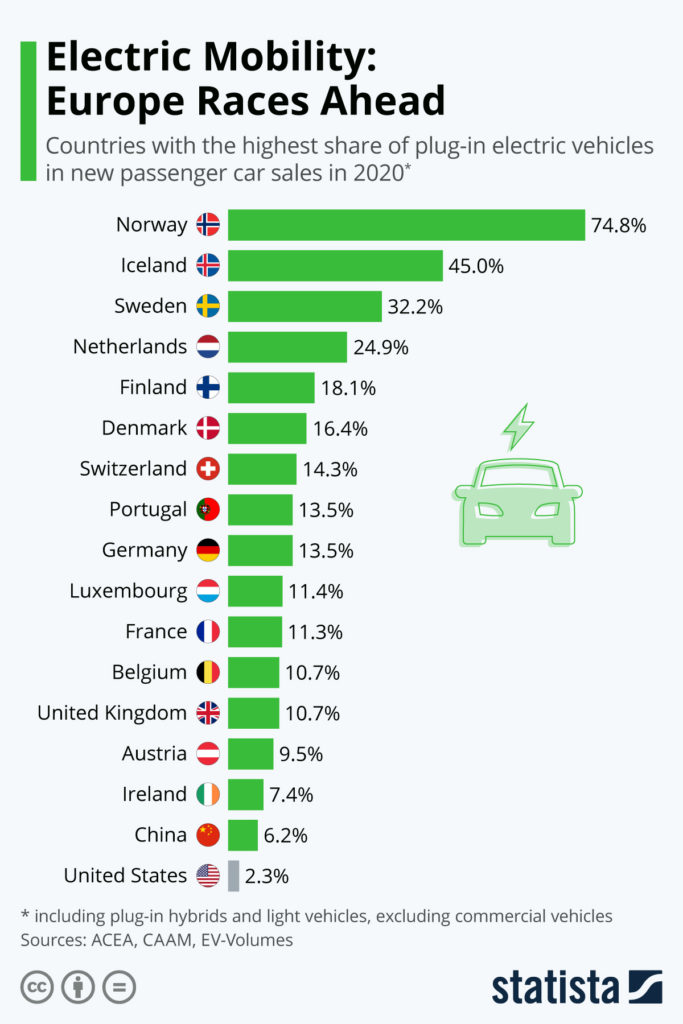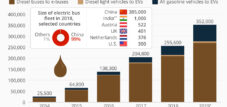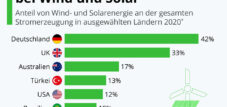Electromobility: Europe is racing forward
Language selection 📢
Published on: May 10, 2021 / update from: May 10, 2021 - Author: Konrad Wolfenstein
Electromobility: Europe is racing forward
Despite difficult circumstances and the negative impact of the pandemic on the automotive industry, electric vehicles took a big leap forward in many countries in 2020. According to estimates by the industry tracker EV Volumes, plug-in electric vehicles accounted for 4.2 percent of global light vehicle sales last year, up from 2.5 percent in 2019. While only eight countries reported an EV share of 5 percent or more in 2019, 13 countries managed to increase the share of electric vehicles in new car sales to over 10 percent in 2020. As in previous years, Norway was a positive outlier with a 75% share of plug-in electric vehicles, while Iceland, Sweden and Finland also featured in the top five - evidence of the rapid adoption of electric cars in the Nordic countries. China, by far the largest electric car market in terms of sales, fell out of the top 10 with a 6.2 percent share of passenger car sales in the country. Meanwhile, the United States fell further behind, with EV share at just 2.3 percent.
While Norway's policies (e.g. tax exemptions, toll exemptions and other incentives) have proven to be very effective in promoting electric cars, the Norwegian model cannot easily be transferred to other countries. First and foremost, the country levies high vehicle import duties and registration taxes, which make cars significantly more expensive than in the USA. By waiving these tariffs on electric vehicles, Norway is subsidizing the purchase of electric vehicles at a level that a larger country like the United States could not afford. Secondly, Norway is a very wealthy country (ironically thanks to its oil reserves) with a high income level. According to the Norwegian Statistics Office, the median household income after taxes was $54,000 in 2018, about the same level as the US but more than twice the EU average.
Electric Mobility: Europe Races Ahead
Despite difficult circumstances and the pandemic's negative impact on the the automotive industry, electric vehicles made a giant leap forward in many countries in 2020. According to estimates from industry tracker EV-Volumes , plug-in electric vehicles accounted for 4.2 percent of global light vehicles sales last year, up from 2.5 percent in 2019. While just eight countries reported an EV share of 5 percent or higher in 2019, 13 countries managed to push electric vehicles past 10 percent of new light vehicle sales in 2020. Like in prior years, Norway was a positive outlier with a 75-percent share of plug-in electric vehicles, while Iceland, Sweden and Finland also featured in the top 5 – a testament to the quick adoption of electric cars in Nordic countries. China, which is by far the largest market for electric cars in terms of unit sales, fell out of the top 10 with electric vehicles accounting for 6.2 percent of passenger car sales in the country. Meanwhile the United States fell further behind with an EV share of just 2.3 percent.
While Norway's policy measures (eg tax exemptions, toll exemptions and other incentives) did prove highly effective in promoting electric cars, the Norwegian model cannot be easily transferred to other countries. First and foremost, the country imposes hefty vehicle import duties and car registration taxes, making cars significantly more expensive than say in the United States. By waiving these duties for electric vehicles, Norway is effectively subsidizing EV purchases at a level that a larger country such as the US couldn't afford. Secondly, Norway is a very wealthy country (ironically thanks to its oil reserves) with a high level of income. According to Norway's national statistical institute , the country's median household income after taxes was around $54,000 in 2018, which is roughly level with the United States but more than twice as high as the EU average.
Suitable for:
- Electromobility: Norway is racing ahead
- Electromobility is coming slowly, but it is coming
- Charging infrastructure for electromobility in Germany



























